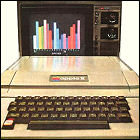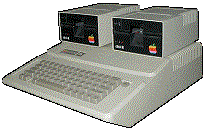 Apple Computer introduces the Apple II home computer system, a pre-built 4K computer (with an optional upgrade to 48K) capable of displaying color graphics on a TV or monitor, and storing programs on either cassette or floppy disk. The computer ships with an implementation of BASIC written by Steve Wozniak, with an optional pair of paddle controllers for games. The system also has an open architecture, with space for expansion cards (and no restriction on what cards can be developed, or by whom).
Apple Computer introduces the Apple II home computer system, a pre-built 4K computer (with an optional upgrade to 48K) capable of displaying color graphics on a TV or monitor, and storing programs on either cassette or floppy disk. The computer ships with an implementation of BASIC written by Steve Wozniak, with an optional pair of paddle controllers for games. The system also has an open architecture, with space for expansion cards (and no restriction on what cards can be developed, or by whom). ![]()
 Steve Wozniak and Steve Jobs founded Apple Computer in the 1970s with the creation of the Apple I, a Heathkit-style, build-it-yourself computer kit. The sales were so promising on the Apple I that the two, with the help from some marketing geniuses of the day, stepped up to a mass-produced, ready-to-use unit called the Apple II. Armed with a cassette data storage device, a couple of small game paddles, and an RF modulator to hook it up to users’ TV sets, the Apple II took off. The beauty of the Apple II’s architecture was its expandibility. When the Apple II+ arrived, there was a disk drive, a dedicated monitor, 48k of RAM (impressive for a home computer around 1980), and third party software publishers were making it a viable platform. Not long after, the Apple IIe hit the market, with 64k of RAM and even more software. The Apple IIc – a heavy all-in-one unit with a built-in floppy drive, 128k of RAM, and a suitcase-style handle – was touted as a portable computer for business, and in 1984, the Apple IIGS appeared, completely changing the structure and offering unbelievable graphics and sound for a home computer at that time. Sadly, around 1984, two other machines yanked the carpet out from under the feet of the Apple II series – IBM’s increasingly prolific PCs, and Apple’s own Macintosh.
Steve Wozniak and Steve Jobs founded Apple Computer in the 1970s with the creation of the Apple I, a Heathkit-style, build-it-yourself computer kit. The sales were so promising on the Apple I that the two, with the help from some marketing geniuses of the day, stepped up to a mass-produced, ready-to-use unit called the Apple II. Armed with a cassette data storage device, a couple of small game paddles, and an RF modulator to hook it up to users’ TV sets, the Apple II took off. The beauty of the Apple II’s architecture was its expandibility. When the Apple II+ arrived, there was a disk drive, a dedicated monitor, 48k of RAM (impressive for a home computer around 1980), and third party software publishers were making it a viable platform. Not long after, the Apple IIe hit the market, with 64k of RAM and even more software. The Apple IIc – a heavy all-in-one unit with a built-in floppy drive, 128k of RAM, and a suitcase-style handle – was touted as a portable computer for business, and in 1984, the Apple IIGS appeared, completely changing the structure and offering unbelievable graphics and sound for a home computer at that time. Sadly, around 1984, two other machines yanked the carpet out from under the feet of the Apple II series – IBM’s increasingly prolific PCs, and Apple’s own Macintosh.
And how did the Apple II handle gaming? The Apple II was my first computer (well, actually, the Franklin ACE 1000, a clone machine that landed Franklin Computers on the losing end of an Apple copyright infringement lawsuit, was my first computer). It not only allowed me to play the games I already loved, such as Zaxxon and Robotron: 2084, but it introduced me to more sophisticated games that my beloved old Atari 2600 and Odyssey 2 consoles would never have been able to handle. Strategic games, simulations, and more. And I could also now program my own games on the Apple II, and I did so quite frequently – or at least I tried to!
When I got that 300 baud modem in 1983, I remember thinking how cool it would be to program a game that two people could play, “live.” And I tried to program it myself, but no other kids at school had an Apple II, so I gave up on it for the time being, instead getting into the world of online Bulletin Board Systems…in other words, the Apple II is responsible for this site’s existence. The earliest LogBook episode guides were written in an Apple II text editor.
- Apple II
- Hard drives at home
- Mystery House (Apple II)
- Microsoft Z80 Softcard
- Apple III
- Ultima
- Telengard (Apple II)
- Ultima II: Revenge Of The Enchantress (Apple II)
- Rocky’s Boots (Apple II)
- Lode Runner (Apple II)
- Ultima III: Exodus (Apple II)
- Pac-Man (Apple II)
- Robotron: 2084 (Apple II)
- Dig Dug (Apple II)
- Music Construction Set (Apple II)
- Apple IIc
- The Newsroom (Apple II)
- The Halley Project (Apple II)
- Ultima IV: Quest Of The Avatar (Apple II)
- The Oregon Trail (1985 version – Apple II)
- Adventure Construction Set (Apple II)
- RACTER (Apple II)
- Garry Kitchen’s GameMaker (Apple II)
- Project Space Station (Apple II)
- Oo-Topos (1986 version – Apple II)
- Hubble Space Telescope (Apple II)
- 8-Bit Weapon: Class Apples
- Break Out: How The Apple II Launched The PC Gaming Revolution
A Phosphor Dot Fossil examined by Earl Green
